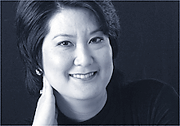Advertisement - Click to support our sponsors.


Changing Hawaii
AN incident in the newsroom a few years ago made me realize that I had a lot to learn when it came to dealing with people with disabilities. Interacting with people
who have difficultiesOne day a colleague of mine, who often used a cane to steady himself, fell right outside my office door. I rushed forward and attempted to pull him up by myself, an impossible feat since he was so much taller and heavier. Panic set in for both us.
Then, to my astonishment, a female co-worker briskly strode over and inquired of the fallen man, "What can I do for you?" When he asked for a chair, she promptly fetched one, whereby he leaned on it and slowly pulled himself upright.
How embarrassing -- for me! In my rush to be helpful, I rushed to judgment. I wrongly assumed to know EXACTLY how to aid someone who (in my mind, anyway) obviously needed my assistance.
But that was mere presumption on my part. And ignorance.
These days I know better, especially after reading a fact sheet from Florida-based Van Vechten & Co. about the Americans with Disabilities Act, which celebrated its 10th anniversary last week.
Signed into law on July 26, 1990, by President Bush, the act was designed to halt discrimination against the estimated 54 million people in this country who have a disability, as defined by the ADA.
For example, according to the Van Vechten mailing, the public needs to know more about referring to and interacting with a person with a disability. These basic guidelines and common courtesies include:
Ask first. Wait until your offer is accepted.Not referring to a person as a cripple, crippled, invalid or handicapped. Instead, say person with disability.
Not calling anyone a victim of, patient of or person afflicted with (blank). He or she is a person who has (blank) or a person who has experienced (blank).
Not saying an individual is restricted to or confined to a wheelchair, or is wheelchair bound. He or she uses a wheelchair.
Not referring to someone who doesn't have a disability as normal, because that implies that people with disabilities are abnormal.
Saying that someone has been disabled since birth or born with (blank), not that he or she has a birth defect. Someone has seizures, not fits. He or she is not slow, but has a developmental delay.
Mentioning the person first, then the disability. For example, say a person with a disability rather than a disabled person.
Avoiding the description of a person as a condition. Thus, he isn't an epileptic but a person with epilepsy. She isn't a post-polio but a person who had polio.
Not using the term handicapped because it connotes the image of a person "standing on the corner with cap in their hand, begging for money. People with disabilities do not want charity. They want to participate equally with the rest of the community."
Refraining from automatically helping people with disabilities. Ask them first. "If you perceive the individual is having difficulty performing some action, offer assistance -- don't be afraid to ask, 'Do you need help?' Then wait until your offer is accepted."
Good advice I won't easily forget again when it comes to the approximately one in five Americans who have a disability, with the likelihood of experiencing a disability rapidly increasing with age.
Diane Yukihiro Chang's column runs Monday and Friday.
She can be reached by phone at 525-8607, via e-mail at
dchang@starbulletin.com, or by fax at 523-7863.